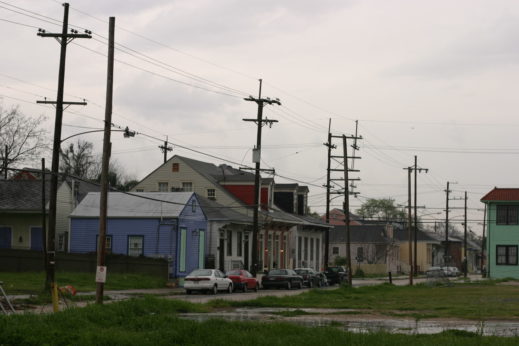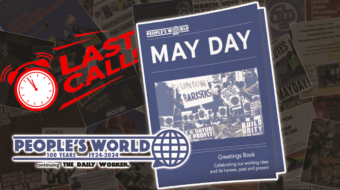
“Do you know what it means to miss New Orleans?” That well known, often recorded song by Eddie DeLange and Louis Alter, was first heard in the 1947 movie New Orleans, performed by Louis Armstrong and sung by Billie Holiday. For such an emblematic piece of music that celebrates the Crescent City, it’s curious that it mispronounces its name! People there say New OR-le-ans, preserving the three syllables in the French town for which it’s named, Orléans—the place where the heroism of Joan of Arc (“The Maid of Orléans”) ended the British siege on May 7, 1429.
No one really knows the exact date of the 1718 founding of the city at a U-shaped bend in the Mississippi River near its mouth, but Joan of Arc’s May 7 is often celebrated.
Louisiana and much of the American Midwest were part of the French overseas empire until President Thomas Jefferson bought the Louisiana Purchase for $15 million in 1803 from a cash-hungry Napoleon who was funding his wars in Europe.
New Orleans—or NOLA to friends—is famous for its music. Songs about the city include “The House of the Rising Sun,” “Proud Mary” and “Big River.” But it was also the home of Dixieland jazz and the port through which many Caribbean rhythms entered the musical language of the United States. Composer Louis Moreau Gottschalk (1829-1869), himself of mixed racial parentage, wrote sophisticated art music derived from African and Latin American themes. In the 19th century New Orleans was one of the most important American centers for opera, often presenting U.S. premieres of French works.
The city’s racial history shares much in common with the rest of the U.S. South. The familiar expression to be “sold down the river” actually refers to enslaved Black people being transported down the Mississippi for resale in one of the country’s largest slave markets. Yet New Orleanians claim a unique view of race, one more open and tolerant given the city’s Spanish and then French rule. People in New Orleans cherished a system of categorizing people according to what percentage of Black ancestry they possessed, and lighter castes, such as quadroons and octaroons, definitely had higher status in the city. Many Black families continue to bear French names dating back up to three centuries.
Miscegenation continued outside the city as well. In the bayous of Southern Louisiana, where the Acadians settled—French-speaking refugees from Canada who were expelled or voluntarily left when the British assumed complete control over Canada—escaped slaves found refuge among the waterways and small villages populated by the Cajuns (shortened from Acadians) and indigenous peoples. Over time, many of these coastal people were able to enter New Orleans passing as white. If the story of race in America is complicated, it is especially so in this part of the country.
New Orleans preserves many of its French traditions, such as Mardi Gras (Fat Tuesday, the day before Ash Wednesday, the beginning of Lent). Until 1803 most of its residents were Roman Catholic; after it became part of the United States, migrants started coming in from the rest of the country and indeed from the rest of the world to make it more culturally cosmopolitan. An immigrant Jew, Judah P. Benjamin, rose to become a United States Senator who resigned and later became Secretary of State for the Confederate States of America. The city is famous for its cuisine, a mélange of French style with the Creole flavors associated with the plentiful seafood in the bayous and Gulf of Mexico. Shrimp, crayfish, oysters and jambalaya are regional specialties.
Tourists are drawn to those aspects of the city that set it apart from the homogenized look of most other American cities. Many think of it as the most “European” city in the United States and enjoy wandering the narrow picturesque streets of the French Quarter and stopping for chicory coffee and the French sugar-dusted doughnuts called “beignets.” They will drop in to Preservation Hall, where traditional Dixieland musicians still play (and charge extra for requests of “When the Saints Go Marching In”). The charming old streetcar, established in 1835, continues to wind its way along St. Charles Avenue, and many ride it just for the views through the mansions of the Garden District, Audubon Park and the Spanish moss hanging from its trees, and out to the campus of Tulane University.
Thousands are attracted every year to the New Orleans Jazz Festival and to the National World War II Museum in the city. Others are drawn to the local literary history: Authors as diverse as George Washington Cable, Mark Twain, Sherwood Anderson, William Faulkner, Walker Percy, Tennessee Williams, Ernest Hemingway, John Grisham, Anne Rice, Eudora Welty and Frances Parkinson Keyes all lived there for some periods of the careers. One well known monument is the statue of Ignatius Reilly, the protagonist of local writer John Kennedy Toole’s beloved novel A Confederacy of Dunces, at 819 Canal St.
Other statues in New Orleans have met a different fate. In 2017, following the revulsion against racist-inspired murders of black worshipers in Charleston, S.C., the City of New Orleans at long last removed four controversial statues that had long antagonized the Black population: The Liberty Place monument that commemorated a Reconstruction Era white supremacist attack on the city’s integrated police force; and statues honoring Confederate leaders Robert E. Lee, Jefferson Davis, and Gen. P.G.T. Beauregard. There still remain the controversial statues honoring other racists Andrew Jackson, Henry Clay, Sieur de Bienville, Edward Douglass White, and John McDonogh, and there are many place and street names throughout the city that could stand some re-evaluation as well.

Economically, the main reason New Orleans exists is to serve as a port at the center of what some have called the world’s busiest port system—Louisiana’s Lower Mississippi River—handling exports from the central Midwest industrial states and imports from abroad. It is the seventh-largest port in the United States by volume of trade, and also serves as a nodal point for cruise ships. Union labor on the docks has been the rule for well over a century, although for decades a dual system of black and white unions prevailed. There were, however, historic accommodations made between them to bring about the solidarity they knew they needed to stand up to the shippers.
More recently, the union movement has taken a beating in the wake of flooding from devastating hurricanes Katrina and Rita and the poorly maintained levee system in the half below-sea-level city. As the city slowly rebuilt, the George W. Bush administration, working with local conservatives, took advantage of the “Shock Doctrine” and completely decimated the powerful, mostly Black teachers union by turning New Orleans into a model city for the non-union charter school movement. Owing to the massive loss of homes in Black wards of the city, large numbers of African-American New Orleanians left for good. In the comeback, the population of the city measurably “whitened.”
Recent New Orleans history has seen a succession of Black men elected as mayor—Ernest Nathan Morial, Sidney Barthelemy, Marc Morial, Ray Nagin—and as of the 2017 elections, its first Black woman mayor, LaToya Cantrell. She succeeded Mitch Landrieu, who was termed out and was the son of a previous mayor, Maurice Edwin “Moon” Landrieu. It recently was revealed that the Landrieu family was itself racially mixed, but both Moon and Mitch were able to pass for white so long as not too many probing questions were asked.
New Orleans is among the wettest cities of America, with an average annual 64 inches of rain. At the same time, owing to the extensive fossil fuel industries of the Gulf Coast, wetlands are fast disappearing as the ocean rises and the coast recedes. Many environmental scientists wonder about the long-term survival for the city. Some prognosticators foresee a city that will one day be forced to move itself farther inland upstream on the river.
But for now, this year in New Orleans, it’s Laissez les bons temps rouler—Let the good times roll—as a unique historic American city marks its 300th birthday.












Comments